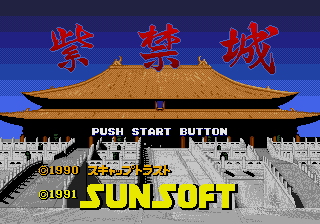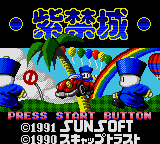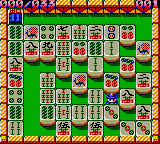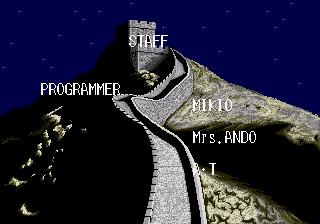Shikinjoh
From Sega Retro
| |||||||||||||||
| Shikinjoh | |||||||||||||||
|---|---|---|---|---|---|---|---|---|---|---|---|---|---|---|---|
| System(s): Sega Mega Drive, Sega Game Gear | |||||||||||||||
| Publisher: Sunsoft | |||||||||||||||
| Developer: Sunsoft | |||||||||||||||
| Licensor: Scap Trust | |||||||||||||||
| Original system(s): JP Home Computers | |||||||||||||||
| Developer(s) of original games: Scap Trust | |||||||||||||||
| Sound driver: Sunsoft sound driver | |||||||||||||||
| Peripherals supported: Mega Modem | |||||||||||||||
| Genre: Puzzle[1][2][3][4] | |||||||||||||||
| Number of players: 1 | |||||||||||||||
| |||||||||||||||
|
Shikinjoh or Shi Kin Joh or Shi-Kin-Joh or Shikinjou (or likewise) (紫禁城) is a 1989/1990 puzzle game by Scap Trust for the PC-88 and PC-98. Sunsoft ported it to the Sega Mega Drive and Sega Game Gear in 1991, with the Mega Drive version having added Mega Modem capabilities. No version has left Japan. A version was later included with Sunsoft's Game no Tetsujin The Shanghai for the Sega Saturn.
The title means "Forbidden City."
Contents
Gameplay
Game Gear version
The game is a puzzle game that plays like a combination of Soukoban and mahjong. The player controls a jiangshi (a reanimated corpse from Chinese folklore) who must clear a path to the exit of each round by pushing mahjong tiles. When two tiles with the same image meet, they both vanish. Each round is a single-screen with no scrolling.
The jiangshi moves in any direction using the D-Pad and pushes tiles by walking into them. Only one tile can be pushed at a time; if a wall or another tile is behind it, the tile cannot be pushed. Tiles can only be pushed forward in the direction that the jiangshi is facing and cannot be pulled, so it is possible to move a tile to a position where it can no longer be moved (possibly rendering a round impossible to complete). Pressing ![]() undoes the last move; pressing
undoes the last move; pressing ![]() raises a menu that allows the player to ask for help (which undoes a move, same as pressing
raises a menu that allows the player to ask for help (which undoes a move, same as pressing ![]() ) or give up (which allows the player to restart the round or play a different round, but only a limited number of times per game).
) or give up (which allows the player to restart the round or play a different round, but only a limited number of times per game).
The minimum number of moves to complete each round is shown in the top-left corner of the screen, along with the number of moves that the player has taken so far (which can be toggled with START ). There is no penalty for taking too many moves to complete a round, and there is no no limit.
There are 100 rounds, with a password given for every five rounds completed. The first five rounds are available at the beginning of the game and can be played in any order, and each password unlocks another five rounds. The last ten rounds have their own special rules, such as tiles that combine to create other tiles or hidden exits.
Tiles
| Normal Tiles (通常牌) | |
|---|---|
| These tiles are erased when two tiles with the same image are pushed together. It is possible to erase more than two tiles in the same move if they are all adjacent to the tile being moved. | |
| Obstruction Tiles (邪魔牌) | |
| These tiles cannot be moved or erased. When a normal tile is pushed into one, it becomes the same as the obstruction tile and likewise immovable. | |
| ? Tiles (?牌) | |
| These tiles cannot be moved. They have an identity, but it is hidden and can only be determined through experimentation; they can be erased if a tile of the same identity is pushed next to it. | |
| Exit (出口) | |
| Bring the jiangshi to the exit to finish the round. |
Stages
- Main article: Shikinjoh/Maps.
Passwords
- Main article: Shikinjoh/Passwords.
Production credits
Mega Drive version
- Programmer: Mikio, Mrs.Ando, A・T
- Designer: I Chan, リョウヘイ バルボア
- Music: A・S・S., Tsukamoto
- Manual: Okazaki, Mori
- Producer: Cho Muso
- Special Thanks: Hirokun, Ikko, Y.Kawabe, Hac.F, Higuchi, Yoshikochan, あつみだっ!, Shige, Yamadada, なおpー, S.Takabayashi, Suzuki
Magazine articles
- Main article: Shikinjoh/Magazine articles.
Physical scans
Mega Drive version
| Sega Retro Average | |||||||||||||||||||||||||||||||||||||||||||||||||
|---|---|---|---|---|---|---|---|---|---|---|---|---|---|---|---|---|---|---|---|---|---|---|---|---|---|---|---|---|---|---|---|---|---|---|---|---|---|---|---|---|---|---|---|---|---|---|---|---|---|
|
| 68 | |
|---|---|
| Based on 9 reviews | |
Game Gear version
| Sega Retro Average | ||||||||||||||||||||||||||||||||||
|---|---|---|---|---|---|---|---|---|---|---|---|---|---|---|---|---|---|---|---|---|---|---|---|---|---|---|---|---|---|---|---|---|---|---|
|
| 68 | |
|---|---|
| Based on 6 reviews | |
Technical information
- Main article: Shikinjoh/Technical information.
References
NEC Retro has more information related to Shikinjoh
|
- ↑ File:Shikinjoh MD JP Box.jpg
- ↑ 2.0 2.1 https://sega.jp/history/hard/megadrive/software_l.html (Wayback Machine: 2020-07-02 23:21)
- ↑ File:Shikinjoh GG JP Box Front.jpg
- ↑ 4.0 4.1 http://sega.jp/fb/segahard/gg/soft_licensee.html (Wayback Machine: 2013-01-01 20:24)
- ↑ File:Shikinjoh MD credits.pdf
- ↑ 1700 igr dlya Sega, "" (RU; 2001-xx-xx), page 268
- ↑ 7.0 7.1 Aktueller Software Markt, "August/September 1991" (DE; 1991-07-26), page 125
- ↑ Beep! MegaDrive, "April 1991" (JP; 1991-03-08), page 30
- ↑ Famitsu, "" (JP; 1991-0x-xx), page 1
- ↑ Hippon Super, "April 1991" (JP; 1991-03-04), page 43
- ↑ Joystick, "Juin 1991" (FR; 1991-0x-xx), page 125
- ↑ Mega Drive Fan, "July 1991" (JP; 1991-06-08), page 85
- ↑ Power Play, "12/91" (DE; 1991-11-13), page 182
- ↑ Sega Saturn Magazine, "September 1995" (JP; 1995-08-08), page 85
- ↑ Beep! MegaDrive, "May 1991" (JP; 1991-04-08), page 29
- ↑ Game Zone, "June 1992" (UK; 1992-05-20), page 78
- ↑ Hippon Super, "April 1991" (JP; 1991-03-04), page 43
- ↑ Joystick, "Juin 1991" (FR; 1991-0x-xx), page 133
- ↑ Sega Saturn Magazine, "September 1995" (JP; 1995-08-08), page 88
| Shikinjoh | |
|---|---|
|
Main page | Comparisons | Maps | Passwords | Magazine articles | Reception | Region coding | Technical information | |










